Related Research Articles
The H-1B is a visa in the United States under the Immigration and Nationality Act, section 101(a)(15)(H) that allows U.S. employers to temporarily employ foreign workers in specialty occupations. A specialty occupation requires the application of specialized knowledge and a bachelor's degree or the equivalent of work experience. The duration of stay is three years, extendable to six years; after which the visa holder may need to reapply. Laws limit the number of H-1B visas that are issued each year: 188,100 new and initial H-1B visas were issued in 2019. Employers must generally withhold Social Security and Medicare taxes from the wages paid to employees in H-1B status.
An L-1 visa is a visa document used to enter the United States for the purpose of work in L-1 status. It is a non-immigrant visa, and is valid for a relatively short amount of time, from three months to five years, based on a reciprocity schedule. With extensions, the maximum stay is seven years.
TN status or TN visa is a special non-immigrant classification in the United States that offers expedited work authorization to a citizen of Canada or a national of Mexico, created as a result of provisions of the North American Free Trade Agreement that mandate simplified entry and employment permission for certain professionals from each of the three NAFTA member states in the other member states.
Labor certification is an immigration process step in the United States of America Its stated goal is to "protect U.S. workers and the U.S. labor market by ensuring that foreign workers seeking immigrant visa classifications are not displacing equally qualified U.S. workers".
An H-2A visa allows a foreign national worker into the United States for temporary agricultural work. There are several requirements of the employer in regard to this visa. The H-2A temporary agricultural program establishes a means for agricultural employers who anticipate a shortage of domestic workers to bring non-immigrant foreign workers to the U.S. to perform agricultural labor or services of a temporary or seasonal nature. In 2015 there were approximately 140,000 total temporary agricultural workers under this visa program. Terms of work can be as short as a month or two or as long as 10 months in most cases, although there are some special procedures that allow workers to stay longer than 10 months. All of these workers are covered by U.S. wage laws, workers' compensation and other standards; additionally, temporary workers and their employers are subject to the employer and/or individual mandates under the Affordable Care Act. Because of concern that guest workers might be unfairly exploited the U.S. Department of Labor Wage and Hour Division is especially vigilant in auditing and inspecting H-2A employers. H-2A employers are the only group of employers who are required to pay inbound and outbound transportation, free housing, and provide meals for their workers. H-2A agricultural employers are among the most heavily regulated and monitored employers in the United States. Unlike other guest worker programs, there is no cap on the number of H-2A visas allocated each year.
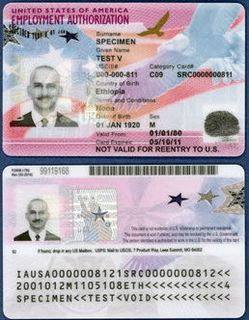
A Form I-766 employment authorization document or EAD card, known popularly as a work permit, is a document issued by the United States Citizenship and Immigration Services (USCIS) that provides temporary employment authorization to noncitizens in the United States.
The Security Through Regularized Immigration and a Vibrant Economy Act of 2007 or STRIVE Act of 2007 is proposed United States legislation designed to address the problem of illegal immigration, introduced into the United States House of Representatives. Its supporters claim it would toughen border security, increase enforcement of and criminal penalties for illegal immigration, and establish an employment verification system to identify illegal aliens working in the United States. It would also establish new programs for both illegal aliens and new immigrant workers to achieve legal citizenship. Critics allege that the bill would turn law enforcement agencies into social welfare agencies as it would not allow CBP to detain illegal immigrants that are eligible for Z-visas and would grant amnesty to millions of illegal aliens with very few restrictions.
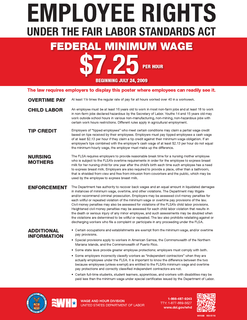
The Fair Labor Standards Act of 1938 29 U.S.C. § 203 (FLSA) is a United States labor law that creates the right to a minimum wage, and "time-and-a-half" overtime pay when people work over forty hours a week. It also prohibits employment of minors in "oppressive child labor". It applies to employees engaged in interstate commerce or employed by an enterprise engaged in commerce or in the production of goods for commerce, unless the employer can claim an exemption from coverage.
The Adverse Effect Wage Rate (AEWR) is the minimum wage that the U.S. Department of Labor (DOL) has determined "must be offered and paid to U.S. and alien workers by agricultural employers of nonimmigrant H-2A visa agricultural workers". Where agricultural employers offer employment to nonimmigrant foreign workers, payment of at least the AEWR is required. Published once a year, usually in early February, by DOL with the assistance of the U.S. Department of Agriculture, the AEWR sets a separate minimum wage rate for each state.
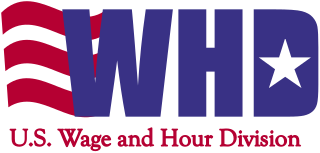
The Wage and Hour Division (WHD) of the United States Department of Labor is the federal office responsible for enforcing federal labor laws. The Division was formed with the enactment of the Fair Labor Standards Act of 1938. The Wage and Hour mission is to promote and achieve compliance with labor standards to protect and enhance the welfare of the Nation's workforce. WHD protects over 144 million workers in more than 9.8 million establishments throughout the United States and its territories. The Wage and Hour Division enforces over 13 laws, most notably the Fair Labor Standards Act and the Family Medical Leave Act. In FY18, WHD recovered $304,000,000 in back wages for over 240,000 workers and followed up FY19, with a record-breaking $322,000,000 for over 300,000 workers.
EB-2 is an immigrant visa preference category for United States employment-based permanent residency, created by the Immigration Act of 1990. The category includes "members of the professions holding advanced degrees or their equivalent", and "individuals who because of their exceptional ability in the sciences, arts, or business will substantially benefit prospectively the national economy, cultural or educational interests, or welfare of the United States, and whose services in the sciences, arts, professions, or business are sought by an employer in the United States". Applicants must generally have an approved labor certification, a job offer, and their employer must have filed an Immigrant Petition for Alien Worker with the USCIS.
The H-2B visa nonimmigrant program permits employers to hire foreign workers to come temporarily to the United States and perform temporary nonagricultural services or labor on a one-time, seasonal, peakload or intermittent basis.
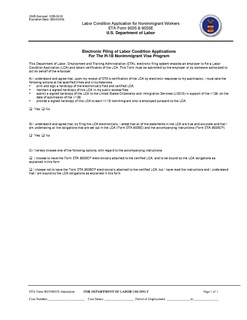
The Labor Condition Application (LCA) is an application filed by prospective employers on behalf of workers applying for work authorization for the non-immigrant statuses H-1B, H-1B1 and E-3. The application is submitted to and needs to be approved by the United States Department of Labor Employment and Training Administration (DOLETA)'s Office of Foreign Labor Certification (OFLC). The form used to submit the application is ETA Form 9035.
The American Competitiveness and Workforce Improvement Act (ACWIA) was an act passed by the government of the United States on October 21, 1998, pertaining to high-skilled immigration to the United States, particularly immigration through the H-1B visa, and helping improving the capabilities of the domestic workforce in the United States to reduce the need for foreign labor.
The H-1B Visa Reform Act of 2004 was a part of Title IV of the Consolidated Appropriations Act, 2005 in the United States that focused on changes to regulations governing H-1B visas. It was a successor to previous legislative changes affecting the H-1B, namely: the Immigration Act of 1990, American Competitiveness and Workforce Improvement Act (ACWIA) of 1998, and the American Competitiveness in the 21st Century Act (AC21) of 2000. The Consolidated Appropriations Act was signed by George W. Bush, then President of the United States, in early December 2004.
The H-1B1 visa is a variant of the H-1B visa in the United States for nationals of Singapore and Chile. The version for Singapore is called the H-1B1-Singapore and the version for Chile is called the H-1B1-Chile. These categories were introduced with the Singapore–United States Free Trade Agreement and Chile–United States Free Trade Agreement respectively, both of which were ratified in 2003 by the 108th United States Congress and became active on January 1, 2004. The visas are also called FTA visas because they were provided for through Free Trade Agreements (FTAs).
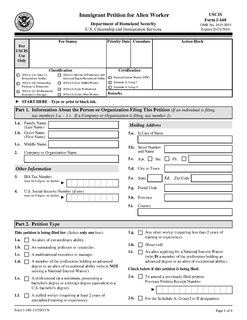
Form I-140, Immigrant Petition for Alien Worker is a form submitted to the United States Citizenship and Immigration Service (USCIS) by a prospective employer to petition an alien to work in the US on a permanent basis. This is done in the case when the worker is deemed extraordinary in some sense or when qualified workers do not exist in the US. The employer who files is called the petitioner, and the alien employee is called the beneficiary; these two can coincide in the case of a self-petitioner. The form is 6 pages long with a separate 10-page instructions document as of 2016. It is one of the USCIS immigration forms.
The term H-1B-dependent employer is used by the United States Department of Labor to describe an employer who meets a particular threshold in terms of the fraction of the workforce comprising workers in H-1B status. An employer classified as H-1B-dependent needs to include additional attestations in the Labor Condition Application used for the petition of any H-1B beneficiary being offered an annual compensation of less than $60,000 and without a master's degree. The notion was introduced by the American Competitiveness and Workforce Improvement Act (ACWIA) passed in 1998 and operationalized through the United States Department of Labor's Interim Final H-1B Rule of December 20, 2000. The regulation is found in 20 CFR 655.736 in the Code of Federal Regulations.
In the United States, the most common visa used for short-term trips is the B visa. This is a combination of the B-1 visa and the B-2 visa. People on B visas are generally not allowed to engage in productive work or study activities. However, in some cases, B visas can be issued that allow people to engage in some types of productive work and learning activity, in lieu of another visa. The three visa categories, for which a B visa could be issued instead, are the H-1B visa, H-3 visa, and J-1 visa. The U.S. Department of State recommends that consular officers clearly annotate such B visas to make the scope of the visa clear to the applicant and the U.S. Customs and Border Protection officer at the port of entry.
The H-1A visa was a visa that was previously available to foreign nationals seeking temporary employment in the United States. These visas were made available to foreign nurses coming into the United States to perform services as a registered nurse in areas with a shortage of health professionals as determined by the Department of Labor. The creation of this visa was prompted by the nursing shortage.
References
- ↑ "Fact Sheet #62F: What records must an H-1B employer make available to the public?" (PDF). August 5, 2019. Retrieved August 5, 2019.
- 1 2 3 4 5 6 7 8 9 10 11 "20 CFR 655.760 - What records are to be made available to the public, and what records are to be retained?". Code of Federal Regulations (mirrored on the website of the Legal Information Institute).
- 1 2 "20 CFR 655.736 - What are H-1B-dependent employers and willful violators?". Code of Federal Regulations (mirrored on the website of the Legal Information Institute). Retrieved June 12, 2016.
- 1 2 3 4 5 6 "The Employment of Non-immigrants on H-1B Visas (PPT)". United States Department of Labor . Retrieved June 12, 2016.
- ↑ "20 CFR 655.731 - What is the first LCA requirement, regarding wages?". Code of Federal Regulations (mirrored on the Legal Information Institute website). Retrieved June 12, 2016.
- 1 2 "20 CFR 655.734 - What is the fourth LCA requirement, regarding notice?". Code of Federal Regulations (mirrored on the Legal Information Institute website). Retrieved June 12, 2016.
- ↑ "TEMPORARY EMPLOYMENT OF FOREIGN WORKERS IN THE UNITED STATES". www.govinfo.gov. Retrieved 2019-12-12.
- ↑ "TEMPORARY EMPLOYMENT OF FOREIGN WORKERS IN THE UNITED STATES". www.govinfo.gov. Retrieved 2019-12-12.